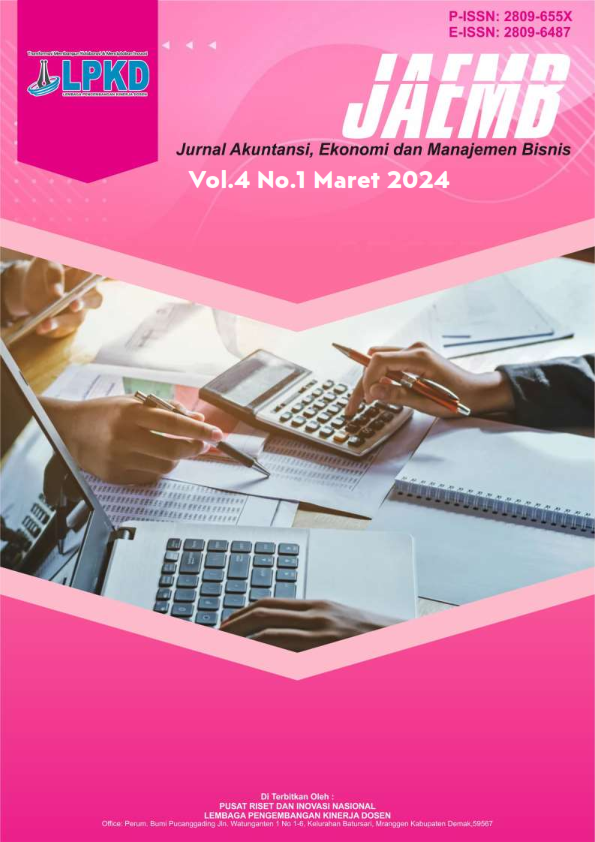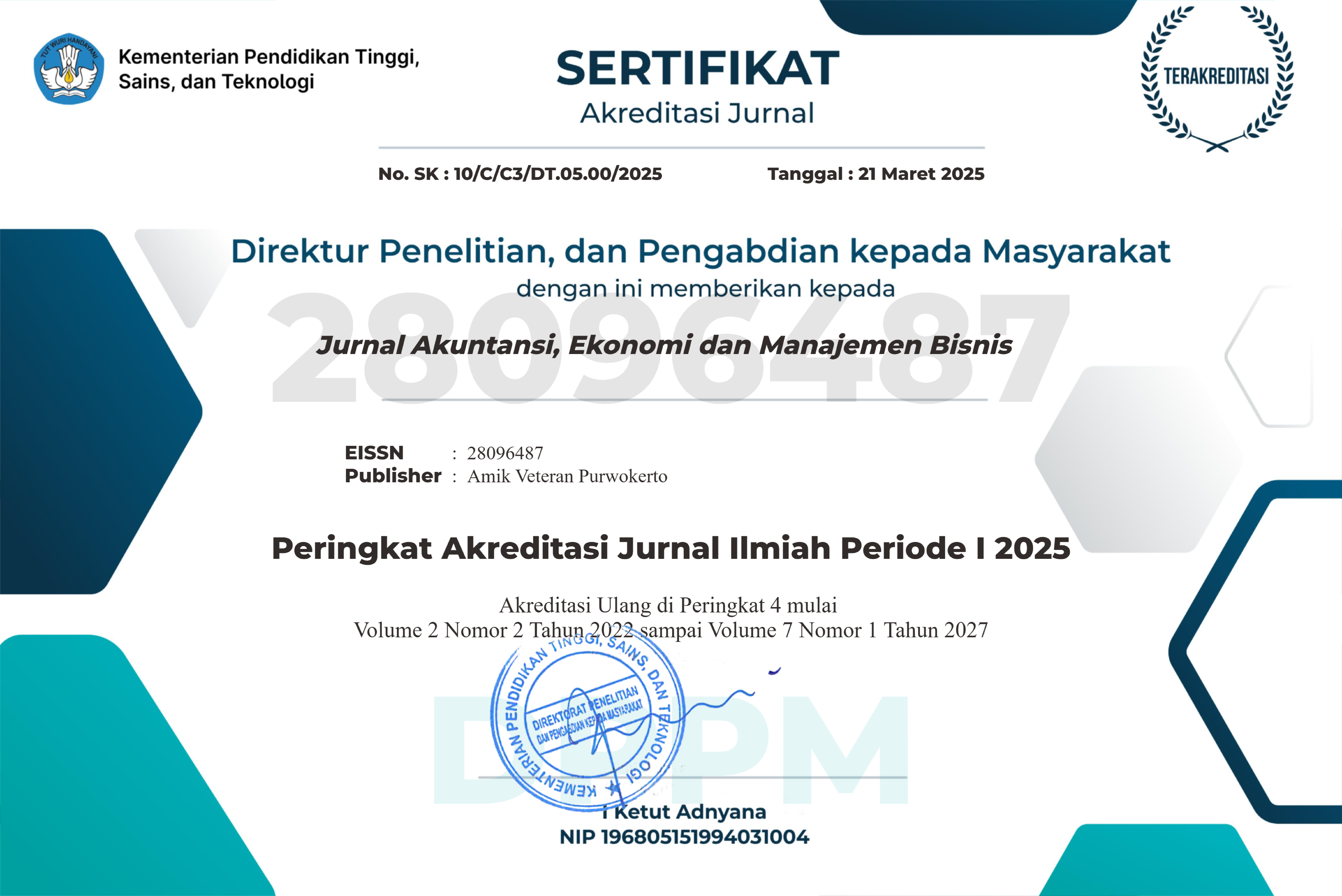Peran Media Sosial: Employer Branding Terhadap Minat Kerja Mahasiswa Tingkat Akhir di Kalimantan Utara
DOI:
https://doi.org/10.55606/jaemb.v5i1.7296Keywords:
employer branding, social media, job application interest, final year students, North KalimantanAbstract
In the competitive digital era, companies are required to build an image as an attractive workplace to capture the attention of young talent, especially generation Z who will enter the job market. This study aims to analyze the effect of employer branding on the interest in applying for jobs of final year students in North Kalimantan, and to examine the role of social media as a moderating variable in the relationship. The study used a quantitative approach with an explanatory design through a survey method of 350 students from two universities, with data analysis using Structural Equation Modeling-Partial Least Squares (SEM-PLS) techniques. Employer branding was measured based on five dimensions of organizational attractiveness, while job application interest and social media exposure were measured using a Likert scale. The results showed that employer branding has a positive and significant effect on job application interest (β = 0.506; p = 0.002), and social media also has a significant direct effect on job application interest (β = 0.573; p = 0.000). However, the moderating effect of social media on the relationship between employer branding and interest in applying was not statistically significant (β = -0.088; p = 0.969). The findings conclude that while social media is effective as a direct communication channel, its success in strengthening employer brand image depends on the quality of content and consistency of the organization's narrative. The implication of this study suggests that local companies should strengthen their employer branding strategy and utilize social media more purposefully and contextually to attract young talent in frontier regions.
References
[1] K. Backhaus and S. Tikoo, “Conceptualizing and researching employer branding,” Career Dev. Int., vol. 9, no. 5, pp. 501–517, 2004, doi: 10.1108/13620430410550754.
[2] P. Berthon, M. Ewing, and L. L. Hah, “Captivating company: Dimensions of attractiveness in employer branding,” Int. J. Advert., vol. 24, no. 2, pp. 151–172, 2005, doi: 10.1080/02650487.2005.11072912.
[3] N. N. Thang and P. T. Trang, “Employer branding, organization’s image and reputation, and intention to apply: the moderating role of the availability of organizational information on social media,” Front. Sociol., vol. 9, no. April, pp. 1–10, 2024, doi: 10.3389/fsoc.2024.1256733.
[4] R. T. Pitaloka and W. Moko, “Pengaruh Employer Branding, Social Media, Dan Corporate Reputation Terhadap Intention To Apply Job,” J. Kewirausahaan dan Inov., vol. 2, no. 4, pp. 1173–1184, 2024, doi: 10.21776/jki.2023.02.4.19.
[5] I. R. Indra and S. Widoatmodjo, “Analisa Strategi Employer Branding terhadap Minat Melamar Kerja,” J. Manaj. Bisnis dan Kewirausahaan, vol. 5, no. 4, p. 414, 2021, doi: 10.24912/jmbk.v5i4.12803.
[6] N. Salamah, T. Purwanto, and C. Rosanti, “Pengaruh Employer Branding, Media Sosial, Dan Persepsi Terhadap Niat Melamar Kerja Pada Industri Startup the Effect of Employer Branding, Social Media, and Perceptions on Intention To Apply for Work in the Startup Industry,” Neraca, vol. 19, pp. 133–146, 2023.
[7] Y. K. Salim and C. W. Widhianto, “The influence of corporate social responsibility, benefits and career development on intention to apply at startup companies mediated by employer brand (Empirical study on Generation Z in Jakarta),” Indones. J. Multidiscip. Sci., vol. 3, no. 12, 2024, doi: 10.55324/ijoms.v3i12.1004.
[8] T. Ambler and S. Barrow, “The employer brand,” J. Brand Manag., vol. 4, no. 3, pp. 185–206, 1996, doi: 10.1057/bm.1996.42.
[9] R. Wilden, S. Gudergan, and I. Lings, Employer branding: Strategic implications for staff recruitment, vol. 26, no. 1–2. 2010. doi: 10.1080/02672570903577091.
[10] D. S. Chapman, K. L. Uggerslev, S. A. Carroll, K. A. Piasentin, and D. A. Jones, “Applicant attraction to organizations and job choice: A meta-analytic review of the correlates of recruiting outcomes,” J. Appl. Psychol., vol. 90, no. 5, pp. 928–944, 2005, doi: 10.1037/0021-9010.90.5.928.
[11] K. A. D. U. Jayatissa, “Insights Into the Next Generation: A Methodological Review of Career Expectations in Generation Z,” J. Bus. Stud., vol. 10, no. 2, pp. 21–39, 2023, doi: 10.4038/jbs.v10i2.96.
[12] R. Phe-, “Economic Theory and Mathematical Economics,” Stoch. Optim. Model. Financ., p. ii, 1975, doi: 10.1016/b978-0-12-780850-5.50001-0.
[13] C. P. Theurer, A. Tumasjan, I. M. Welpe, and F. Lievens, “Employer Branding: A Brand Equity-based Literature Review and Research Agenda,” Int. J. Manag. Rev., vol. 20, no. 1, pp. 155–179, 2018, doi: 10.1111/ijmr.12121.
[14] A. M. Sivertzen, E. R. Nilsen, and A. H. Olafsen, “Employer branding: Employer attractiveness and the use of social media,” J. Prod. Brand Manag., vol. 22, no. 7, pp. 473–483, 2013, doi: 10.1108/JPBM-09-2013-0393.
[15] F. Lievens, “Employer branding in the Belgian army: The importance of instrumental and symbolic beliefs for potential applicants, actual applicants, and military employees,” Hum. Resour. Manage., vol. 46, no. 1, pp. 51–69, 2007, doi: 10.1002/hrm.20145.
[16] A. Kapoor, “Threat and vulnearbilty for Social Media Marketing,” SSRN Electron. J., 2022, doi: 10.2139/ssrn.4267948.
[17] R. B. F. Khan, “Exploring the Impact of Employer Branding on Intention towards Job Application: The Mediating Role of Social Media,” Asian J. Econ. Bus. Account., vol. 24, no. 3, pp. 172–180, 2024, doi: 10.9734/ajeba/2024/v24i31250.
[18] D. J. Ketchen, “A Primer on Partial Least Squares Structural Equation Modeling,” Long Range Plann., vol. 46, no. 1–2, pp. 184–185, 2013, doi: 10.1016/j.lrp.2013.01.002.
[19] J. E. Harris and P. M. Gleason, “Application of Path Analysis and Structural Equation Modeling in Nutrition and Dietetics,” J. Acad. Nutr. Diet., vol. 122, no. 11, pp. 2023–2035, 2022, doi: 10.1016/j.jand.2022.07.007.
[20] A. Dabirian, J. Kietzmann, and H. Diba, “A great place to work!? Understanding crowdsourced employer branding,” Bus. Horiz., vol. 60, no. 2, pp. 197–205, 2017, doi: 10.1016/j.bushor.2016.11.005.
[21] Badan Pusat Statistik Kalimantan Utara. (2025). Keadaan Ketenagakerjaan Provinsi Kalimantan Utara Februari 2025. kaltara.bps.go.id
Downloads
Published
How to Cite
Issue
Section
License
Copyright (c) 2025 Jurnal Akuntansi, Ekonomi dan Manajemen Bisnis

This work is licensed under a Creative Commons Attribution-ShareAlike 4.0 International License.








